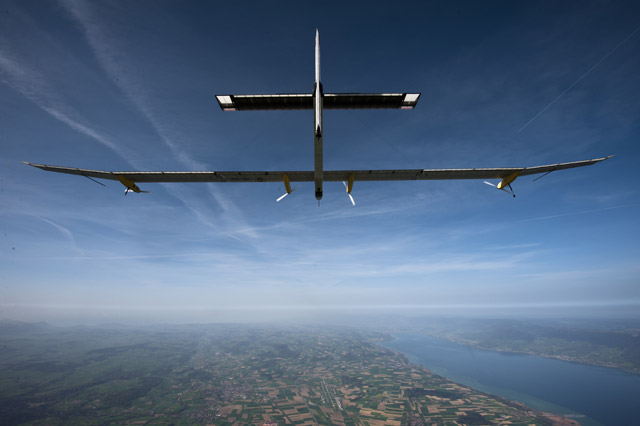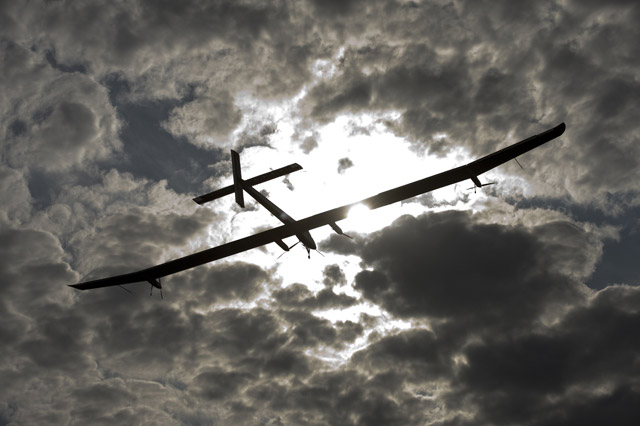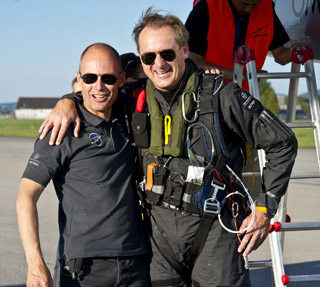To fly for more than 24h with no fuel through a full day-and-night cycle in a solar-powered aircraft certainly counts as an aviation milestone. And if the Solar Impulse project extends that 2010 feat with a round-the-world trip in 2015, another noteworthy aviation first will have been notched up.
But while project founders André Borschberg and Bertrand Piccard are both dedicated and accomplished aviators, for them Solar Impulse is not really about aviation. Rather, the purpose of Solar Impulse is to demonstrate that mankind can, if it chooses to do so, meet its formidable environmental challenges with technology that is essentially available today.
 |
|---|
Solar Impulse Solar Impulse has four electric motors across the wingspan of an Airbus A320 |
As Piccard put it recently at the project's test base in Payerne, Switzerland, Solar Impulse is about "real technology for the future. That is why this aeroplane is here, what it stands for". Piccard, a medical doctor whose aviation pedigree includes the 1985 European acrobatic hang-gliding title and captaining the 1999 Breitling Orbiter non-stop round-the-world balloon flight, firmly believes that a new age of environmentally sustainable living is within our grasp. Since the 1970s, he notes, the Green movement emerged with a message that the only hope for the planet was to decrease mobility, lifestyle, industry and growth. Industry, naturally, wants to carry on increasing all these things, so "these two groups were fighting for 30 or 40 years with no solution", he says.
But the battle lines shifted dramatically with the recent arrival of the so-called cleantech movement. Piccard now sees a powerful way forward, and while he recognises that laboratories, start-up firms and even large companies are embracing ways to slash power consumption, he believes there remains a huge challenge to change people's thinking about what is possible.
POSITIVE EMOTIONS
By combining a relentless push to slash aircraft weight and maximise energy efficiency with the very visible - and visibly exciting - example of a solar-powered aeroplane, the real goal of Solar Impulse, he says, "is to create positive emotions around new technologies". And, he believes, what can be achieved in a flying machine should be much easier on the ground, where 97% of the world's CO2 emissions are generated.
Piccard cites the example of Solar Impulse's 2012 mission, an eight-leg, 6,000km round trip between Payerne and Rabat, Morocco, via Madrid, completed in July. In Morocco, he says, the government is enthusiastic about solar power but what many villages see as progress is "a cable bringing power from the capital". After the flight, though, there are villages asking for local solar-power solutions.
Borschberg - a mechanical engineer, former Swiss air force pilot, consultant and entrepreneur - points out that just two of Solar Impulse's technology partners are in aviation: Dassault and Germany's DLR research agency. The others are about meeting the project's energy efficiency demands.
And while it has been achievement enough to create an aircraft with four electric motors spread across the wingspan of an Airbus A320 but the mass of a family car, those efficiency demands are getting much tougher to meet. In order to fly round the world, the team must now build a larger, more capable aircraft capable of sustaining legs of five to six days. Such a journey will place much greater demands on the single pilot, so a larger cockpit will be needed. But since overall aircraft size can grow only marginally before it becomes impossible to control, the materials used to build the second aircraft will have to be dramatically lighter by volume, and energy management must be improved even further. The plan is to build the second aircraft at Solar Impulse's engineering workshop in Zurich, conduct test flights from Payerne in 2014 and make the round-the-world flight in 2015.
Joining Borschberg and Piccard in Payerne was Patrick Thomas, chief executive of official partner Bayer MaterialScience, whose contribution to date has included work by about 30 engineers developing many of the ultra-lightweight materials that have made Solar Impulse possible. Renewing Bayer's technical and cash commitment to the project, Thomas noted that meeting the extreme performance challenges Borschberg and Piccard have been laying down since 2003 has resulted in new materials for use by Solar Impulse and many for use in industries ranging from automotive to construction.
One good example of such a step forward is to be deployed in the cockpit, which weighs 19kg in the existing aircraft. In the second machine, the surface area of the cockpit will be three times as large, but thanks to carbon nanotube-reinforced carbon fibre structures and a new, lighter polycarbonate windscreen mass will be kept below 30kg.
Many weight-saving materials pioneered by Solar Impulse will certainly find their way into aircraft, and Thomas believes that when the second iteration of Solar Impulse gets off the ground in 2014 it may be the first aircraft to fly with carbon nanotube-reinforced composites. But illustrating the hopefully positive connection between Solar Impulse-driven technology development and mass-market benefits, Thomas expects the automotive industry to be the more immediate beneficiary, as car makers - like airframers - are keenly aware of the connection between weight reduction and fuel economy. A 10% reduction in vehicle weight reduces fuel consumption by 5%, he notes, adding that car makers are already using polycarbonate cousins of the Solar Impulse windscreen to reduce the weight of the roof on new models. The objective there, he adds, is not mere weight reduction, but to lower a car's centre of gravity and thus reduce demands on the suspension, which can then be lighter - a great example of the virtuous cycle of weight reduction.
ENCOURAGING EFFICIENCY
However encouraging Solar Impulse's energy efficiency may be - and Borschberg likes the fact that it is possible to take off early in the morning with just enough power in the batteries to get airborne, have them full by evening and then land at midnight with a half load, potentially selling excess power to the grid - electric-powered aircraft with any significant payload capability are a very long way off. However, any weight-reduction advances spurred by the project could lead to relatively immediate benefits on the road. The tank-to-wheel energy efficiency of a normal car is barely 20%, notes Piccard ("They are rolling heaters") but electric vehicles, just now beginning to appear on the market in more than negligible numbers, can achieve a comparable figure of 90%.
The pair are nothing if not bold, but they do readily admit that for all their success to date, the ultimate aim of a round-the-world flight remains a challenge - and not just in technology terms. While European airspace has been so far open to their experimental aircraft - in addition to test flights and the Morocco expedition, they flew to Le Bourget to show Solar Impulse at the 2011 Paris air show - and they are reasonably confident that permission to fly in the US can be obtained, they accept that it will come down to a political decision whether or not they can cross China in 2015. But, they point out, the biggest hurdles may be raised in countries with particularly challenging bureaucratic regimes, such as India.
 |
|---|
Solar Impulse Solar Impulse flew a full day-and-night cycle with no fuel successfully in 2010 |
Meanwhile, while preparations continue for the 2015 circumnavigation, Piccard and Borschberg and their project partners are exploring possibilities for raising the funds - and overcoming a few regulatory hurdles - to take their message to the biggest energy-consuming market of all, the USA. The pair would like to ship Solar Impulse to the West Coast to embark on one of aviation's "legendary" flights, crossing the continent. "The pioneering spirit," says Piccard, "needs flexibility, not routines."
Another of Borschberg and Piccard's strong suits is vision. Borschberg, who claims to spend 75% of his time on Solar Impulse - that means 18hrs a day, as "24hrs would be 100%" - doesn't hesitate when asked about life after arriving back in Payerne following the 2015 mission. "It will be the beginning!" he says, as the project then becomes a vehicle for communicating the energy message, to schools and other audiences.
Piccard, who describes Solar Impulse as being "made of opportunities", has another dream, too. Standing aside this elegant aircraft in its vast hangar in Payerne, he wonders if, when it's all over, Solar Impulse might find a permanent home in Washington DC, in the Smithsonian Institution - perhaps next to his Breitling Orbiter balloon flight capsule.
SWISS DREAM TEAM
 |
|---|
Solar Impulse Piccard (left) greets Borschberg on arrival at Le Bourget for the 2011 Paris air show |
Borschberg flew jets in the Swiss air force for 20 years, holds professional fixed and rotary-wing licences and does aerobatics in his spare time. A graduate of the Ecole Polytechnique Fédérale de Lausanne in mechanics and thermodynamics, he went on to graduate studies in management in Switzerland and at the Massachusetts Institute of Technology before joining consultants McKinsey, where he worked for five years before embarking on a self-employed career as an entrepreneur and venture capitalist.
With his 1999 Breitling Orbiter round-the-world balloon flight, Piccard holds the aviation record for duration and distance with co-pilot Brian Jones. An early enthusiast of hang-gliders and microlights, he also flies aeroplanes, gliders and motor gliders, while as a psychiatrist fascinated by human behaviour in extreme conditions, Piccard has also developed self-hypnosis and micronapping techniques to extend endurance by allowing partial rest during long flights.
AT THE CONTROLS
For all that Solar Impulse is seen by its founders as principally an energy efficiency project, there is no escaping the fact that André Borschberg and Bertrand Piccard have set themselves what amounts to an extreme aviation challenge.
So far, the aircraft itself has demonstrated the ability to fly day and night without fuel. But the limits of solar power technology mean the minimalist machine can provide only the barest of creature comforts, so its flight time is limited to what the pilot can endure.
At cruising altitude of 9,000m (30,000ft), outside temperatures are -40˚C and conditions inside the cockpit can range from -20˚C to +35˚C. The larger, more comfortable aircraft being constructed for the 2015 round-the-world flight will have a cockpit large enough for the pilot to change clothes, and segments will be limited to five or six days - a huge leap from the 26h that Borschberg has managed so far.
No airline or even military transport pilot would be expected to last so long at the controls, but many may learn from Piccard, who next year will be demonstrating self-hypnosis and micronapping techniques to allow full and partial rest during a 72-hour simulation flight, during which time he will be live online and in contact with followers.
Flying Solar Impulse demands careful routing and attention to weather. It cannot withstand a lightning strike, and must avoid downdrafts.
But any pilot naturally loves to fly a unique machine and, says Piccard, "to sit in the cockpit is to be in a privileged position". Solar Impulse, he says, "is the craziest [aircraft] ever built".
"[Or] maybe the Wright Brothers' was the craziest."
Source: Flight International























